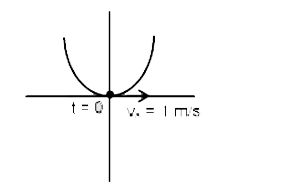Starting at time t = 0 from the origin with speed 1ms−1 , a particle follows a tow - dimensional trajectory in the x - y plane so that its coordinates are related by the equation y=x22 . The x and y components of its acceleration are denoted by ax and ay respectively . Then, the incorrect statement is:
ax=1ms−2 implies that when the particle is at the origin ay=1ms−2
ax=0 implies ay=1ms−2 at all times
at t=0 the paritcles velcoity points in the x - direction
ax=0 implies that at 1 = 1s the angle between the particle 's velocity and the x aixs is 45∘
The correct Answer is:A
y=x22

dydt=12×2×dxdt
vy=xvx
dvydt=dxdt×dxdt+X(d2vxdt2)
ay=v2x+xax
If x=0,ay=v2x=1, No matters what is the value of a hence option A is incorret .
If ax=0 then x = v xt = t
then angle made by velocity vector with x - axis .
tanθ=vyvxx=1⇒θ=45
Related Playlists
- BOOK - JEE ADVANCED PREVIOUS YEARCHAPTER - JEE (ADVANCE) 2020EXERCISE - SECTION 36videos
JEE (ADVANCE) 2020
- BOOK - JEE ADVANCED PREVIOUS YEARCHAPTER - JEE (ADVANCE) 2020EXERCISE - SECTION 36videos
JEE (ADVANCE) 2020
- BOOK - JEE ADVANCED PREVIOUS YEARCHAPTER - JEE ADVANCEDEXERCISE - PHYSICS SECTION - IV Matrix Match Type2videos
JEE ADVANCED
Similar Questions
A particle moves along a curve so that its coordinates at time t are x = t, y=12t2,z=13t3. The acceleration at t = 1 is
View SolutionA particle moves in the x−y plane such that its coordinates are given x=10√3t,y=10t−t2 and t is time, find the initial velocity of the particle.
View SolutionA ball is projected from origin at time t= 0. The x and y coordinates of its displacement are given by (x=4t2) and y=(3t−5). Then its instantaneous velocity at any time t is
View SolutionThe x and y coordinates of a particle at any time t are given by x=7t+4t2 and y=5t, where x and t is seconds. The acceleration of particle at t=5s is
View SolutionA particle moves along x axis in such a way that its coordinate x varies with time t according to the equation x=A0−A1t+A2t2. The initial velocity of the particle is.
View SolutionStarting from the origin at time t = 0 , with initial velocity 5ˆjms−1 , a particle moves in the x - y plane with a constant acceleration of (10ˆi+4ˆj)ms−2 . At time t , its coordinates are (20m,y0m) . The value of t and y0 are , respectively :
View SolutionA particle moves in the x-y plane. It x and y coordinates vary with time t according to equations x=t2+2t and y=2t. Possible shape of path followed by the particle is
View SolutionA paricle starting from the origin (0,0) moves in a straight line in (x,y) plane. Its coordinates at a later time are (√3,3). The path of the particle makes with the x-axis an angle of
View SolutionA particle starting from the origin (0,0) moves in a straight line in the (x,y) plane. Its coordinates at a later time are (√3,3). The path of the particle makes with the x-axis an angle of
View SolutionA particle starting from the origin (0,0) moves in a straight line in the (x,y) plane. Its coordinates at a later time are (√3,3). The path of the particle makes with the x-axis an angle of
View Solution


